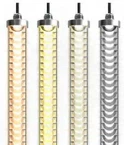There are numerous types of cables available, each designed for specific purposes and applications. Here are some commonly used types of cables:
1. Ethernet Cable:
Also known as a network cable or LAN cable, Ethernet cables are crucial for connecting devices within a local area network (LAN) to enable data transfer and network communication. They come in various categories, such as Cat5e, Cat6, and Cat6a, each supporting different speeds and bandwidths. For instance, Cat6 cables can handle speeds up to 10 Gbps over short distances, making them ideal for high-performance applications like gaming or streaming. Ethernet cables are typically used to connect routers, switches, computers, and other network devices, ensuring stable and reliable internet connections.
2. USB Cable: USB (Universal Serial Bus) cables are used to connect various devices such as computers, smartphones, printers, and cameras to transfer data or charge the devices.They facilitate data transfer and charging, with different types such as USB-A, USB-B, USB-C, and Micro USB. USB-C, in particular, is becoming increasingly popular due to its reversible design and ability to support faster data transfer rates and higher power delivery. USB cables are essential for everyday tasks, such as syncing files between devices, charging smartphones, and connecting peripherals like keyboards and mice.
3. HDMI Cable: HDMI (High-Definition Multimedia Interface) cables are used to transmit audio and video signals between devices such as televisions, monitors, DVD players, and gaming consoles.
HDMI cables support various resolutions, including 4K and 8K, and can carry both video and audio signals in a single cable, simplifying connections. Additionally, HDMI cables can support advanced features like Ethernet connectivity and audio return channels, making them ideal for modern home entertainment setups.
4. VGA Cable: VGA (Video Graphics Array) cables are used to transmit analog video signals between computers and monitors or projectors.
Although they have largely been replaced by digital connections like HDMI and DisplayPort in modern devices, VGA cables are still prevalent in some legacy systems and older projectors. VGA supports resolutions up to 1080p, but the quality can degrade over longer distances due to its analog nature. Users often rely on VGA cables for presentations or connecting older equipment to display devices.
5. DisplayPort Cable: DisplayPort cables are used to connect computers, laptops, or graphics cards to monitors or display devices, supporting high-resolution video and audio transmission.
They are particularly favored in professional environments and among gamers due to their ability to support higher refresh rates and resolutions than HDMI in some scenarios. DisplayPort also features a locking mechanism to ensure a secure connection and can daisy-chain multiple monitors, allowing users to expand their workspace easily. Additionally, DisplayPort can carry audio signals and support advanced features like adaptive sync technology.
6. DVI Cable: DVI (Digital Visual Interface) cables are used to transmit digital or analog video signals between computers or DVD players and monitors or projectors.
DVI comes in several formats, including DVI-D (digital only), DVI-A (analog only), and DVI-I (integrated, supporting both digital and analog). This flexibility makes DVI a popular choice for connecting various display devices, especially in computer setups. While DVI does not carry audio signals, it can support high resolutions, making it suitable for graphic-intensive applications and gaming.
7. Audio Cables: These include various types such as RCA cables, 3.5mm audio cables, and XLR cables, used to connect audio devices like speakers, headphones, microphones, and musical instruments.
RCA cables are commonly used to connect audio and video equipment, such as televisions and sound systems, while 3.5mm audio cables are standard for headphones and portable devices. XLR cables, known for their durability and ability to minimize noise, are widely used in professional audio settings, connecting microphones to mixers or audio interfaces. These cables play a vital role in ensuring high-quality sound reproduction for both personal and professional use.
8. Coaxial Cable: Coaxial cables are used for cable television (CATV) connections, internet connections (using cable modems), and other applications requiring the transmission of high-frequency electrical signals.
Their construction, which includes a central conductor, insulating layer, and outer shielding, helps reduce signal interference and maintain quality over long distances. Coaxial cables are also used in various applications, such as connecting antennas to televisions and transmitting data in certain networking setups. Their reliability and ability to handle high-frequency signals make them a staple in both residential and commercial installations.
9. Power Cables: These include AC power cables used to connect devices to electrical outlets, as well as DC power cables used to supply power to devices like laptops, monitors, or routers.
AC power cables are commonly used for standard household appliances and electronics, while DC power cables are used for devices like laptops, monitors, and routers. These cables come in various configurations, including different plug types and voltages, to accommodate diverse devices and regions. Additionally, power cables must adhere to safety standards to prevent electrical hazards, making them a critical component in any electrical setup.
10. Fiber Optic Cable: Fiber optic cables use thin strands of glass or plastic to transmit data as pulses of light, enabling high-speed and long-distance data transmission for telecommunications and networking purposes.
They are increasingly used in telecommunications and networking due to their ability to carry vast amounts of data with minimal signal loss and resistance to electromagnetic interference. Fiber optic cables come in two main types: single-mode, which is used for long-distance communication, and multi-mode, suitable for shorter distances. Their high bandwidth capabilities make them ideal for internet service providers and data centers, supporting the growing demand for fast and reliable connectivity.
These are just a few examples of the many types of cables available. Each type has its own specifications and uses, catering to different connectivity and transmission requirements. These expanded descriptions provide a deeper understanding of the various types of cables, their functionalities, and their applications in everyday technology and professional environments.
You can browse the relevant product links in our website for more information.
Hydget Cables
Welcome to contact us
Contact: Ricky Li
Whatsapp: +86 152 5199 6760
Wechat: +86 152 5199 6760
Email: rickyli@hydget.com







